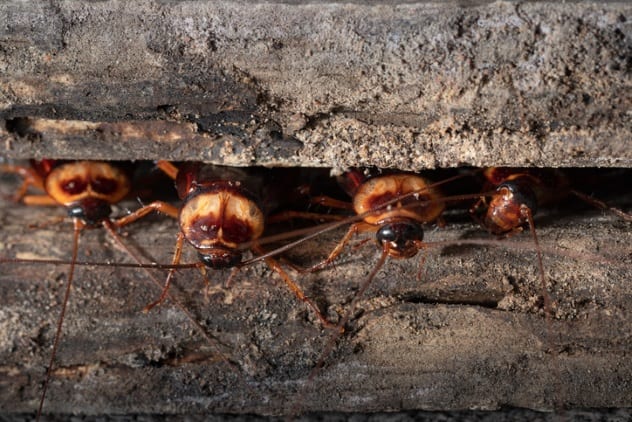 Music
Music  Music
Music  History
History 10 Less Than Jolly Events That Occurred on December 25
 Weird Stuff
Weird Stuff 10 Funny Ways That Researchers Overthink Christmas
 Politics
Politics 10 Political Scandals That Sent Crowds Into the Streets
 Weird Stuff
Weird Stuff Ten Bizarre Facts About The Doge Meme
 Our World
Our World 10 Ways Your Christmas Tree Is More Lit Than You Think
 Movies and TV
Movies and TV The 10 Coolest Stars to Set Sail on The Love Boat
 History
History 10 Things You Didn’t Know About the American National Anthem
 Technology
Technology Top 10 Everyday Tech Buzzwords That Hide a Darker Past
 Humans
Humans 10 Everyday Human Behaviors That Are Actually Survival Instincts
 Music
Music 10 Surprising Origin Stories of Your Favorite Holiday Songs
 History
History 10 Less Than Jolly Events That Occurred on December 25
 Weird Stuff
Weird Stuff 10 Funny Ways That Researchers Overthink Christmas
Who's Behind Listverse?

Jamie Frater
Head Editor
Jamie founded Listverse due to an insatiable desire to share fascinating, obscure, and bizarre facts. He has been a guest speaker on numerous national radio and television stations and is a five time published author.
More About Us Politics
Politics 10 Political Scandals That Sent Crowds Into the Streets
 Weird Stuff
Weird Stuff Ten Bizarre Facts About The Doge Meme
 Our World
Our World 10 Ways Your Christmas Tree Is More Lit Than You Think
 Movies and TV
Movies and TV The 10 Coolest Stars to Set Sail on The Love Boat
 History
History 10 Things You Didn’t Know About the American National Anthem
 Technology
Technology Top 10 Everyday Tech Buzzwords That Hide a Darker Past
 Humans
Humans 10 Everyday Human Behaviors That Are Actually Survival Instincts
10 Things You Wouldn’t Believe Cause Allergies
Allergies are our body’s natural response to certain things it considers dangerous. They are often triggered by food, although they can also be set off by animals, electrical appliances, drugs, and even other medical conditions.
What many don’t realize is that these allergies are sometimes caused by something other than what they think. For instance, chocolate allergy is typically the result of neither cocoa nor any other ingredient in chocolate. It’s actually caused by cockroach bits in the chocolate. Here are nine more examples, not all of which are confirmed or recognized by medical science.
10 Cockroaches Cause Chocolate Allergy

Some people complain of being allergic to chocolate. However, as teased above, people who think they are allergic to chocolate are probably actually allergic to the cockroach parts that often end up in chocolate. It’s all good, though. The cockroach parts in question are ground up.
You’d think ground-up roaches would be enough reason for the Food and Drug Administration to fine the chocolate makers, but the FDA actually permits them have a maximum of 60 insect parts per 100 grams of chocolate. The average chocolate bar has eight parts.
Cockroaches often end up in chocolate at cocoa bean farms, where they sneak into the harvest. Farmers already use several pesticides to keep them at bay but would need more if they wanted to get rid of the roaches completely. That would mean your favorite chocolate would be filled with pesticides, which is more dangerous than pieces of cockroaches.
Besides chocolate, cockroach parts can also trigger allergies in foods like peanut butter, macaroni, popcorn, cheese, wheat, and fruits.[1]
9 Vaccines Are Claimed To Cause Peanut Allergy

Peanut allergy is common in young children, with millions of kids in the US affected. According to some rather . . . fringe sources, vaccines are a major cause of peanut allergy in today’s children.[2] Refined peanut oil, a major ingredient in vaccines, is why. Vaccine makers need to add oil to preserve their vaccines and ensure that the human body can fight the weakened diseases in the vaccines.
Several oils can be used, but vaccine makers allegedly prefer refined peanut oil because it is cheap. However, the oil is said to cause hypersensitivity (aka serum sickness) in some children. These children will later become allergic to peanuts and products containing them. Note, however, that there is no scientific evidence to back this proclaimed link between vaccination and peanut allergy.
8 Something Else Could Be Causing Wi-Fi Allergies

Electromagnetic hypersensitivity (EHS) is an allergy supposedly caused by being close to items that emit electromagnetic signals. This includes cell phones, computers, and Wi-Fi. We say “supposedly” because the allergy is not medically recognized.
The World Health Organization (WHO) insists EHS is not a real medical condition, even though it agrees that its symptoms are real. Dr. James Rubin, a psychologist at King’s College, London, believe EHS is real but is not caused by electromagnetic fields.
A 2009 report on 46 studies into EHS indicated the sample groups could not determine when the devices emitting the electromagnetic signals were on or off. Nevertheless, people have continued to claim to have the allergy. Sufferers claim electromagnetic signals cause severe headaches, nausea, fatigue, and dizziness, which disappears when they leave the vicinity of the offending device.
In Massachusetts, the parents of a 12-year-old sued his private school, claiming that the school’s Wi-Fi caused several EHS symptoms, including nosebleed and heart palpitations, in their son. Curiously, doctors could not diagnose the supposed ailment because it disappeared when the boy was out of school.
In France, a woman suffering from EHS left her home to live in the mountains to escape from electromagnetic signals. The parents of a 15-year-old UK girl blamed EHS for their daughter’s suicide. They claimed the Wi-Fi signals in her school left her disoriented and sick, causing her to take her own life.[3]
7 Dogs Can Get Allergies From Eating The Same Food

Dog owners are often surprised to see their dog suddenly become allergic to a food they have been eating for some time. In truth, dogs can develop allergies from eating the same food over a long period of time.
The allergies can manifest from eating the same brand of food, or foods containing the same sources of protein. The body dealing with these same ingredients or proteins over and over leads to allergies to the food. This is why food allergies are more common in dogs over the age of two.
The most common food allergens for dogs are beef, milk, cheese, chicken, and wheat. Eggs, corn, lamb, soy, yeast, spices, and additives are also suitable candidates.[4]
6 Airborne Particles Cause Allergies To Air Conditioning

It is impossible to become allergic to air conditioners. People who think they are allergic to air conditioning are actually reacting to whatever is in the air the air conditioner blows. The so-called air conditioner allergy is often caused by pollen, dust mites, dander, mold, toxins, bacteria, viruses, air pollution, or toxic chemicals.
Air conditioners do not create but only spread these allergens around the room. Pollen enters the building through open doors and windows or via the clothes and shoes of people entering the building. It could also be from the plants inside the building. Toxic chemicals are often expelled from certain products like household cleaners.[5]
5 Baby Wipes Could Cause Food Allergies

Baby wipes are the latest products said to be causing food allergies in babies. Researchers say this happens because the soap and soap-like materials in baby wipes may disturb the chemicals in the top layer of the skin.
Some children have genes that could cause any interaction with these chemicals to lead to food allergies. This is why researchers have suggested that parents avoid wipes entirely and use water to clean their babies instead.
However, the research is not conclusive, and others have suggested that baby wipes do not cause food allergies in children. This is because a widely reported study which indicated that baby wipes cause allergies was conducted on newborn mice and not newborn humans.[6]
4 Dead Skin Causes Allergies To Birds And Dogs

Some people often report that they are allergic to dogs. However, they are not actually allergic to dogs but to the dander, as in the dead skin on the dog. They could also be allergic to the saliva and urine of the dog or the pollen or mold that is usually on dog fur.
Dander is carried in the air and is often littered around the home or wherever the dog visits. This is why people allergic to dogs usually also have reactions to areas dogs frequent—even when the dog is not around. Researchers have discovered that people who are allergic to dogs have a highly sensitive immune system that reacts to dog dander, urine, or saliva as if it were some form of pathogenic invader and attacks it promptly.[7]
Similarly, people aren’t truly allergic to birds, either. They’re really allergic to the dander on the feathers of the birds as well as the dust mites that feed on it. The dander and dust mites are often spread when the birds flaps its wings.
3 Parasites Cause Swimmer’s Itch

Chlorine rash is often confused with swimmer’s itch. While both are caused by swimming, it is virtually impossible to get both from the same body of water. Chlorine rash only appears after swimming in water that contains chlorine, while swimmer’s itch only happens in water without chlorine.
First, swimmer’s itch is an allergic reaction, while chlorine rash is not. Humans cannot develop allergies to chlorine. Instead, we can only become sensitive to chlorine. A continuous reaction between our skin and the chlorine causes chlorine rash.
Swimmer’s itch (also known as cercarial dermatitis) is caused by a parasite. It often appears after swimming in lakes, ponds, and sometimes salt water. However, it rarely happens in swimming pools because chlorine prevents the parasites from thriving.
The parasites are first dumped into the water as eggs in the feces of beavers, muskrats, waterfowl, and several other animals that live near the water. Then they hatch and are picked up by a kind of snail before they are ultimately released into the water again.
The parasites burrow into the exposed skin of human swimmers, causing an allergic reaction in the swimmer. Fortunately, humans are not every good hosts, and the parasites die off after a few days.[8]
2 Folic Acid Could Cause Allergies In Unborn Children

Pregnant women are often advised to ingest a number of vitamins and minerals to have a healthy baby. Folic acid (also called folate) is one of the most important. It is basically the artificial version of vitamin B9.
Women are advised to ingest folic acid in the first trimester (first three months) of pregnancy. However, research by the Robinson Research Institute of the University of Adelaide indicates that ingesting folic acid after the first trimester could cause allergies in the unborn child.
However, like the baby wipe entry, this, too, was declared inconclusive because the study was limited to sheep. Researchers discovered that lambs often had allergies to dust mite and egg albumen if their mothers ingested folic acid late into pregnancy.[9]
1 Allergic Eczema Is Linked To Food Allergies In Children

Allergic eczema appears when a part of the skin touches whatever a person is allergic to. It is indicated by a dry, itchy rash that may be painful and accompanied by blisters.
However, recent research indicates that the eczema is linked to allergies in children. Today, 20 percent of children are affected by allergic eczema. Curiously, 30 percent of those children suffer from food allergies.
Researchers have discovered that the skin closest to the eczema spots usually have different molecular structures than other areas of the skin in children who have food allergies. However, the skin around the eczema in children with no food allergies is the same.
Researchers believe the difference in the molecular structure is the reason some children with allergic eczema have food allergies, and others don’t. They also believe an understanding of the molecular structures could allow them to detect food allergies in children earlier.[10]
Read about more bizarre allergies on 10 Allergies You Never Thought Could Exist and 10 Wacky Allergies To Things Other Than Foods.








